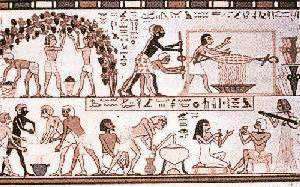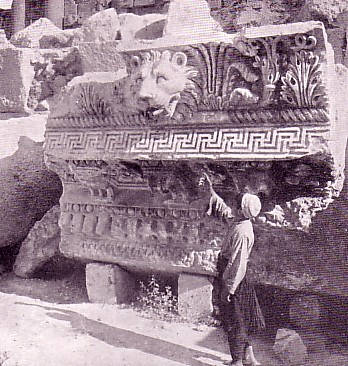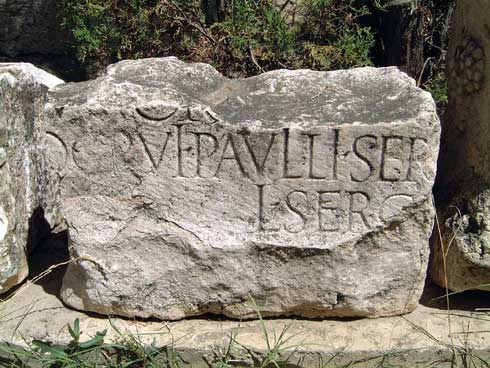The Historical Accuracy of the Bible
 To be divinely inspired, a book must be historically accurate. For if its credibility cannot be established on the basis
of known events, it certainly cannot be relied upon as an adequate guide in matters beyond our ability to check. On the
other hand, if we can demonstrate that such a book is correct
in historical matters, to an extent unknown among human
writings, then we have strong evidence that the authors were
inspired by God. In this lesson we shall learn that this is true
of the Bible.
To be divinely inspired, a book must be historically accurate. For if its credibility cannot be established on the basis
of known events, it certainly cannot be relied upon as an adequate guide in matters beyond our ability to check. On the
other hand, if we can demonstrate that such a book is correct
in historical matters, to an extent unknown among human
writings, then we have strong evidence that the authors were
inspired by God. In this lesson we shall learn that this is true
of the Bible.
Down through the centuries, enemies of the Bible have
attacked its historical accuracy. Time after time, the Scriptures have been thus questioned, only later to be shown correct by archaeology. Archaeology is a study of relics, monuments, tombs, artifacts, etc., of ancient civilizations. Peoples
and events, known before only in Biblical accounts, have been brought to light by the excavations of ancient cities.
Always, the Bible has been proven right. Let us consider a
few of the cases of such findings:
Grapes In Egypt:
 In Genesis 40 we are told how Joseph
interpreted the dream of Pharaoh's butler. In this dream
grapes are mentioned. But the ancient historian, Herodotus,
states that the Egyptians grew no grapes and drank no wine,
and many therefore questioned the accuracy of the biblical
account. However, paintings discovered on the ancient Egyptian tombs, show the dressing, pruning, and cultivating of the
vines, and also the process of extracting the juice of grapes,
as well as scenes of drunkenness. There can be little doubt
then that Herodotus was wrong and the Bible right.
In Genesis 40 we are told how Joseph
interpreted the dream of Pharaoh's butler. In this dream
grapes are mentioned. But the ancient historian, Herodotus,
states that the Egyptians grew no grapes and drank no wine,
and many therefore questioned the accuracy of the biblical
account. However, paintings discovered on the ancient Egyptian tombs, show the dressing, pruning, and cultivating of the
vines, and also the process of extracting the juice of grapes,
as well as scenes of drunkenness. There can be little doubt
then that Herodotus was wrong and the Bible right.
The Bricks Of Pithom:
In Exodus 1:11, we are told that the children of Israel built the treasure cities of Pithom and Raamses for Pharaoh. In Exodus 5, we are informed that they made bricks first using straw, and then using stubble, because no straw was furnished them for that purpose. In 1883, Naville, and in 1908, Kyle, found at Pithom, one of the cities built by Israel, that the lower courses were built of bricks filled with good, chopped straw. The middle courses have less straw including stubble. The upper courses were made of pure clay, with no straw whatever. It is difficult to read the biblical account and not be astonished at the amazing confirmation which archaeology here has given to the Bible.
The Hittites:
 Forty-eight times in the Scriptures, a people called the Hittites are mentioned. We find them blocking
Israel's path as it sought to enter the promised land. We read
of Uriah, the Hittite, whom David sent to his untimely death.
However, in all the records of antiquity, not a reference to
those people was to be found, and therefore, the skeptics
attributed them to the imagination and fiction. In 1876, George Smith, began a study of monuments at a place called
Djerabis in Asia Minor. This city proved out to be old Carchemish, a capital of the ancient Hatti. We now know that the
Hatti were the Hittites of the Bible, who, according to Prof.
A.H. Sayce, "contended on equal terms with both Egypt and
Assyria." The Hittites not only proved to be a real people, but
their empire was shown to be one of the great ones of ancient times.
Forty-eight times in the Scriptures, a people called the Hittites are mentioned. We find them blocking
Israel's path as it sought to enter the promised land. We read
of Uriah, the Hittite, whom David sent to his untimely death.
However, in all the records of antiquity, not a reference to
those people was to be found, and therefore, the skeptics
attributed them to the imagination and fiction. In 1876, George Smith, began a study of monuments at a place called
Djerabis in Asia Minor. This city proved out to be old Carchemish, a capital of the ancient Hatti. We now know that the
Hatti were the Hittites of the Bible, who, according to Prof.
A.H. Sayce, "contended on equal terms with both Egypt and
Assyria." The Hittites not only proved to be a real people, but
their empire was shown to be one of the great ones of ancient times.
Sargon:
 In Isaiah 20:1, we read, "In the year that Tartan
came unto Ashdod, (when Sargon the king of Assyria sent
him)..." This is the only mention of King Sargon in the Bible,
and the only one in ancient literature. His place in history
was severely questioned on this account. But in the years,
1842-1845, P.E. Botta, uncovered the tremendous royal palace of Sargon. Among the other things discovered was an
account of the siege of Ashdod mentioned in Isaiah. Once
more the Bible was right, the critics wrong.
In Isaiah 20:1, we read, "In the year that Tartan
came unto Ashdod, (when Sargon the king of Assyria sent
him)..." This is the only mention of King Sargon in the Bible,
and the only one in ancient literature. His place in history
was severely questioned on this account. But in the years,
1842-1845, P.E. Botta, uncovered the tremendous royal palace of Sargon. Among the other things discovered was an
account of the siege of Ashdod mentioned in Isaiah. Once
more the Bible was right, the critics wrong.
The Flood:
Genesis 7 and 8 tell us of the destruction of the
world by a great flood. To many, the story of the flood is
actually a recording of ancient myths. However, we have much evidence outside the Bible to show that the flood was
a reality and that the Bible is true. Notice the flood traditions
of ancient peoples. One scholar lists 88 different traditional
accounts. Almost all of these agree that there was a universal destruction of the human race and all living creatures by
a flood. Almost all agree that an ark or a boat was the means
of escape. Almost all are in accord in saying that a seed of
mankind was left to perpetuate the race. Many add that wickedness of man brought about the flood. Some even mention
Noe. Several speak of the dove and the raven, and some
discuss a sacrifice offered by those who were saved. To anyone familiar with the biblical account, the similarity is astounding. The universality of this tradition is such as to establish
that the biblical flood was not a figment of someone's imagination.
In 1872, George Smith, discovered the now famous Babylonian flood tablets. In these, a certain person was told to
build an ark or ship and to take into it seed of all creatures.
He was given the exact measurements and was instructed to
use pitch in sealing it. He took his family into the boat with
food. There was a terrible storm which lasted six days. They
landed on Mt. Nazir. He sent out a dove. It came back. He
sent out a swallow. It came back. He sent out a raven and it
flew back and forth over the earth. When these people were
safely out of the boat, they offered sacrifice to the gods. The
account differs from the Bible in some particulars, but is so
much in agreement with the Scriptures as to make one wonder how the historical nature of the flood could be questioned.
Furthermore, archaeology has found positive evidence of
a great flood in some ancient cities. At Susa, a solid deposit
of earth five feet thick was found between two distinct civilizations. The nature of the deposit establishes beyond doubt
that Susa was completely destroyed by a flood which was not
merely local. At Ur, the ancient home of Abraham, a similar
deposit of water laid clay eight feet thick was found. This
deposit clearly shows that Ur was destroyed by a flood of such proportions that is must have been a vast flood such as
the one of the Bible. Further evidence could be presented,
but this should be sufficient to demonstrate that the Biblical
flood was a reality.
Jericho:
Joshua 6, tells how Israel conquered the walled
city of Jericho. For six day they marched once around the
city. On the seventh day they went around it seven times.
The priests blew their trumpets, the people shouted, and when they did, "The wall fell down flat" (Joshua 6:20). The people then rushed strait way into the city and burned it. They
took none of it to themselves. They saved Rahab who lived
in a house upon the wall and who had helped them previously.
Starting in 1929, Dr. John Garstang, excavated the ruins
of ancient Jericho. His discoveries corresponded remarkably
with the Biblical account. Jericho, he found, had a double
wall, with houses built across the two walls. This explains
how Rahab's house could have been built upon a wall. He
learned that the wall was destroyed by some kind of violent
convulsion such as that described in the Bible, and that when
the wall feel that it fell outward, down the hillside, or as the
Bible says, it fell down flat. Had the wall been destroyed by
the battering rams of an enemy army, the walls would have
fallen inward instead of outward. Furthermore, the city had
been burned. Once again, the spade of archaeology has
established the accuracy of the Bible.
Sergius Paulus, The Proconsul:
 In Acts 13:7, mention is
made of Sergius Paulus, the proconsul of Cyprus. For a long
time, skeptics contended that Luke should have called him
propraetor instead of proconsul since this was the usual title.
However, coins discovered on Cyprus, have positively established that the governors of Cyprus were proconsuls. One
such coin found at Soli on Cyprus bears the inscription, "Paulus the Proconsul", very possibly referring to the very man
mentioned in Acts.
In Acts 13:7, mention is
made of Sergius Paulus, the proconsul of Cyprus. For a long
time, skeptics contended that Luke should have called him
propraetor instead of proconsul since this was the usual title.
However, coins discovered on Cyprus, have positively established that the governors of Cyprus were proconsuls. One
such coin found at Soli on Cyprus bears the inscription, "Paulus the Proconsul", very possibly referring to the very man
mentioned in Acts.
Confirmation By Non-Biblical Writers:
Some Biblical accounts have been substantiated by non-Biblical writers. For example: the Jewish historian Josephus has said many things concerning facts in the Bible. For example: in Matthew 14:3,4, we are told that Herod put John the Baptist to death for the sake of Herodias, his brother Philip's wife, because John had informed Herod that it wasn't lawful for him to have her as his wife. Josephus tells us why it was unlawful. Herodias had originally been married to Herod's brother, Philip. But she divorced Philip and married Herod. this unlawful marriage was the occasion of John's rebuke. The account of Josephus and the Bible are in perfect accord.
Apparent Inconsistencies:
Apparent inconsistencies fade away whenever the Bible is studied with an open mind.
An example is found in regard to the ruling family of Palestine
In Matthew 2:1, we read of "Herod the King" who was reigning
when Jesus was born. Matt. 2:19 records his death. Yet in Acts 12:12, we read once more of "Herod the King" putting
James to death. How could he do this if he were already dead? Does the Bible contradict itself? Josephus, an unbeliever in Christ, explains the difficulty by showing that Herod
of Acts 12, was actually the grandson of the Herod mentioned
in Matthew 2. The Bible agrees perfectly with the facts.
Again, Luke 2:1, mentions "Caesar Augustus" as the ruling
monarch of the Roman Empire. In Luke 3:1, we are told that
John the Baptist began his ministry in the fifteenth year of
the reign of Tiberius Caesar. This shows that Augustus was
no longer on the throne. Still later in Acts 25:21, we find Paul
appealing his arrest to Augustus. A superficial reading might
lead us to suppose that the Bible contradicts itself. But on
close examination, with other known facts, we find that the
emperor at that time was Nero, whose full name was Caesar
Augustus Nero. Of this Albert Barnes says, "The reigning emperor at this time was Nero. The name Augustus properly denotes that which is venerable, or worthy of honour and reverence. It was first applied to Caesar Octavianus, who was the Roman emperor in the time when our Saviour was born, and who is usually called Augustus Caesar. But the title continued to be used of his successors in office, as denoting the veneration or reverence which was due to the rank of emperor."
The attacks upon the credibility of the Bible have served
to make stronger, not weaker, the conviction of every lover
of the true Word of God.